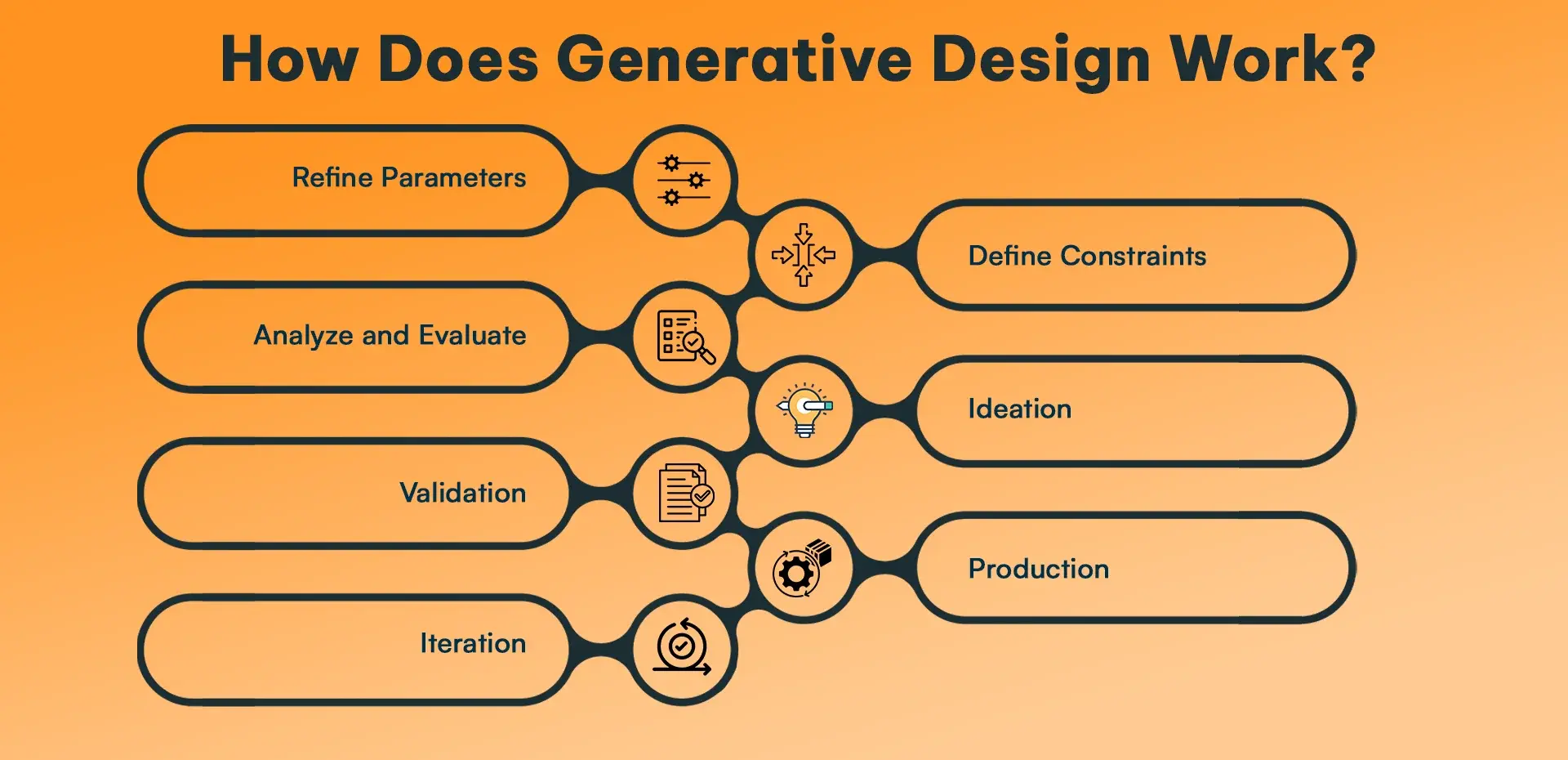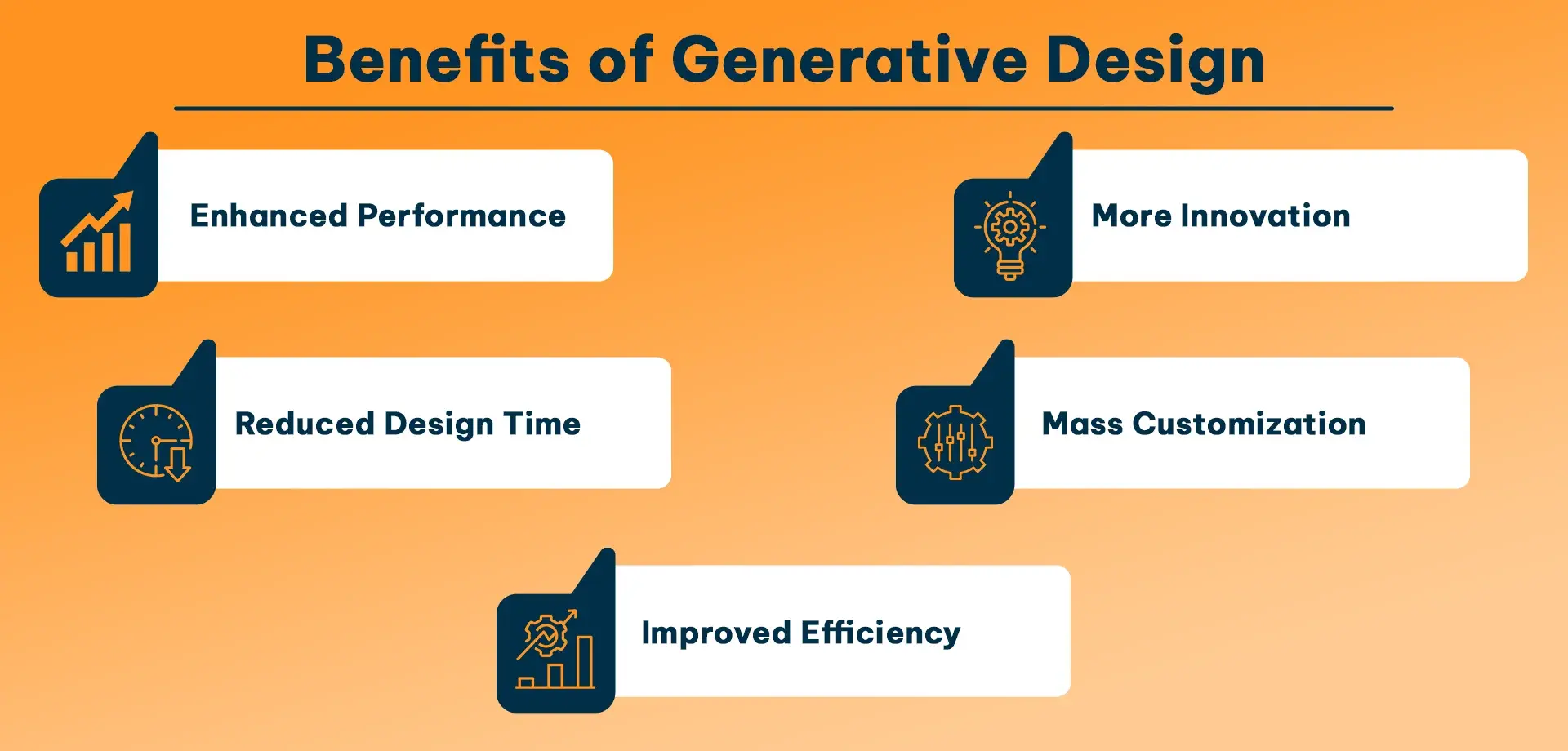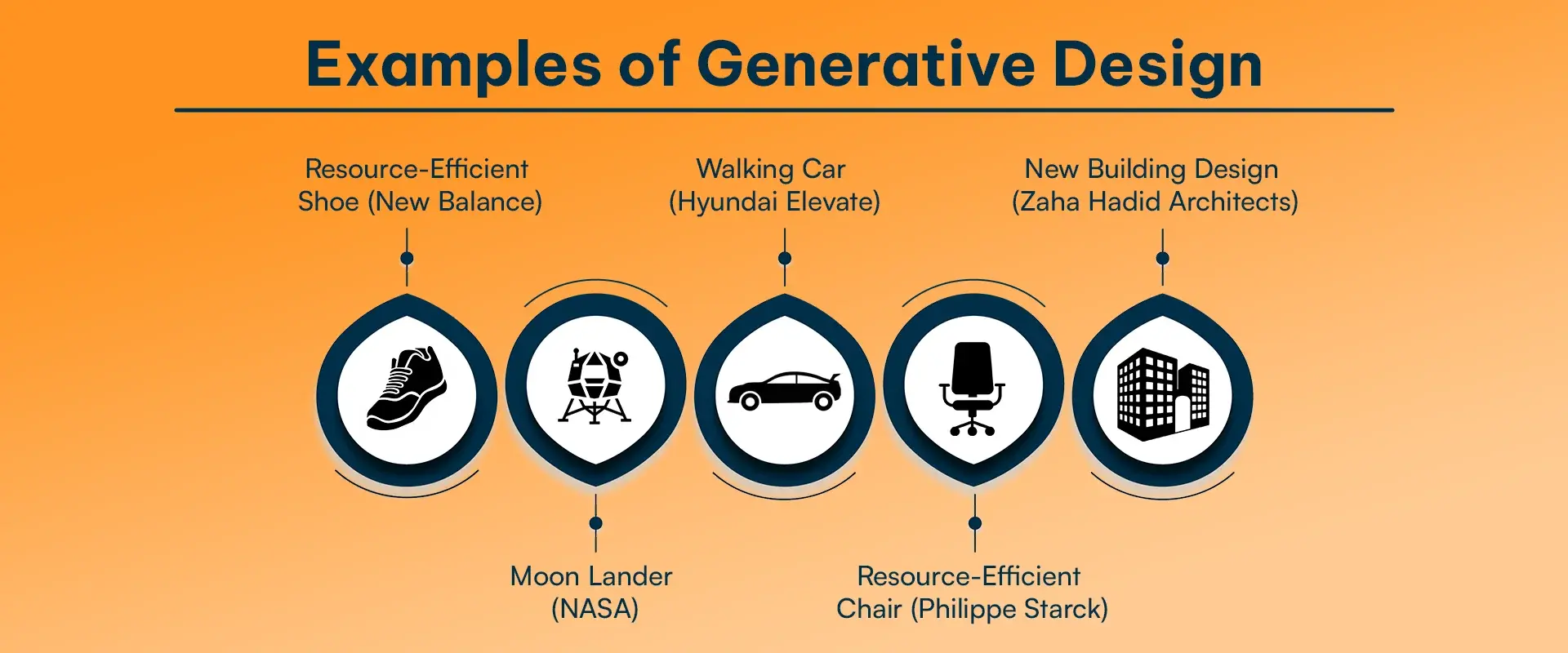
Just imagine that you have to design a UI for a software, and your client does not have an exact idea of the UI, due to which when you designed 2 UI samples of the software and the client did not like them, he said that he wanted a different one, it gets very frustrating for the designers to revise it again and again and this happens not only in UI designing but in all creative tasks.
Generative Design is solving all these issues to a great extent, like in our UI scenario, generative design can suggest hundreds of optimal UI designs according to the client’s goals, which will not only save time but also provide a lot of options to clients and businesses. Generative design is used by engineers, architects, and product engineers to tackle complex challenges and designs.
Today, in this article, we will try to learn about Generative AI in detail, including its process, benefits and use cases.
Quick Summary
Aerospace engineering, product designing, and architecture designing are complex professions of the world, where even a slight flaw in the design can prove to be a disaster like The Quebec Bridge collapse. Therefore, traditional designers used to analyse hundreds of designs from different perspectives and try to fix their flaws; this used to be a very time and energy-consuming field.
But since generative design has come into the market, it has become possible to effectively tackle challenging designs. This AI system tries to provide multiple solutions according to the project or requirements, based on set constraints. Generative AI helps a lot in refining parameters and simulations, which reduces design time and enhances innovation.
Generative design is being used most in aerospace, automotive, consumer goods, and architecture.
What Is Generative Design?
Generative design is an AI-powered design process used by different designers and engineers to make their products or project designs more effective by first giving their input, mentioning their goals and constraints (like size, weight, strength, material, cost), after which the software suggests alternative designs and solutions, taking into account the input.
While in traditional CAD design, engineers test and create single models, generative design provides multiple options to choose from, all of which are already optimized based on specific parameters.
Generative Design most used Industries:
-
Automotive: Generative designs help engineers design lighter as well as stronger parts so that better fuel efficiency and performance can be maintained.
-
Aerospace: Commercial plane manufacturers like Boeing and Airbus use generative AI to try to make planes lighter so that they can be fuel-efficient. Generative AI enhances aerodynamics.
Airbus uses generative designs to optimize the wingtip of its planes, and even NASA used it in designing its Moon lander.
-
Architecture and Construction: This design process helps in making more sustainable and resilient designs. Heydar Aliyev Centre in Azerbaijan is the best example of how managing high-density urban housing demand is not that difficult if human expertise and generative designs are used together.
-
Consumer Goods: This makes it possible to make products that improve performance and lower costs. Companies like Philippe Starck use this to make chairs using minimal materials.
-
Industrial Machinery: Generative designs help in making parts from less material so that the product is lightweight while maintaining its structural integrity.
This idea is not only to automate the complex designing industry but also to take the creativity of human designers to the next level. Because it is better to create all the designs manually than to let the designer use their creativity to set a product vision and goal, and when the generative design software gets the perfect input, it will be able to provide multiple solutions.
How Does Generative Design Work?
There is no one-click solution in generative design like image generation. It involves a lot of human expertise along with a series of steps that try to give the best solution or design by understanding the engineering goals through machine intelligence and natural language. Let's understand it step by step.

1. Refine Parameters
Generative designs follow an iterative process to refine parameters, which gives numerous solutions by understanding the project objectives, constraints, requirements and goals. It also reports on how the project cost and weight goals can be achieved in its final recommendation.
2. Define Constraints
It includes generative design performance targets, in which it analyzes safety limits, load paths, environmental impacts in great detail and with proper data and guides for such manufacturing techniques that minimize negative impact and keep safety standards high.
3. Analyze and Evaluate
As we know, it analyzes generative design goals and requirements, and for this, it simulates the generated designs through software. In this, it uses virtual testing methods for analysis of structural stress.
4. Ideation
The special thing about Artificial Intelligence is that it can provide hundreds or even thousands of solutions to any problem. This gives designers and engineers creative ideas, and if they are already working on a design, then they get more ideas about how they can make their designs even perfect.
5. Validation
When a design is finalised, a prototype of its design is created and it is tested to ensure that the design or model performs as per the expectations in real-world scenarios.
6. Production
Once the design is approved, manufacturing of the prototype begins using 3D printing or CNC machines.
7. Iteration
This cycle continues until designers find an optimal design that satisfies the project goals.
That is why the modern industry extensively uses generative design as it helps a lot in prototyping, testing, and designing, which saves a lot of money and time.
Benefits of Generative Design
Generative Design has a lot of benefits at the industry level, but let's try to understand the benefits of generative design in more detail.

1. Enhanced Performance
Generative design creates lighter, stronger, and more durable designs of mechanical parts, which are already optimized according to the application and working conditions.
2. Reduced Design Time
Many experts say that generative design accelerates R&D by automating repetitive and complex design tasks. This saves a lot of work.
3. Improved Efficiency
Generative design improves the design of mechanical parts a lot, due to which assembling multiple parts in a single design becomes easy,y and this also reduces material waste.
4. Mass Customization
Generative design helps to scale products to individual-level customer needs without increasing the operational costs of the company.
5. More Innovation
When designers and engineers have a choice of a wide range of designs, they will be able to handle innovation more effectively. And innovation through traditional processes is quite difficult.
The main goal of generative design is not to replace human designers or prototype engineers; its main goal is to make the designing and solution process fast and effective so that human designers can launch the best innovation and product from their skill set.
Also Read: How Can Generative AI Be Used In Cybersecurity
What Are the Limitations of Generative Design?
As we know that no technology or software can ever be flawless, it is not correct to consider generative AI as perfect. Because the generative designs model is quite evolving, many times, experts have issued usage guidelines for it.

1. Paradox of Choice
Many times it has been seen in surveys that when designers have a lot of design options, it makes it difficult for them to decide on the right design.
2. Bias
How perfect the output of an AI is depends largely on its training, and if it is trained on a biased system, the AI may unintentionally favour certain outcomes based on historical data, even if the data is incomplete.
3. Guiding the Software
When perfect input is given to generative design software, the results are perfect. Hence, human expertise is very important for defining meaningful constraints.
4. Quality Concerns
Generative design sounds futuristic, but in reality, not all designs are perfect for prototypes, because coach designs may meet the technical criteria but fail in practical application.
Examples of Generative Design
Well, we have understood generative design in a lot of detail, now let's know about its examples

1. Resource-Efficient Shoe (New Balance)
Generative Design can easily develop midsoles using AI-designed lattice structures for better performance and less material waste. This saves a lot of resources along costs.
2. Moon Lander (NASA)
NASA used generative design software in the design of many of its satellites, even the moon lander, to make it lighter, stronger so that it can handle the harsh conditions of the outer atmosphere.
3. Walking Car (Hyundai Elevate)
The Hyundai company has publicly released the concept of a new car whose design uses very unique leg-like parts that will help it walk on uneven terrain.
4. Resource-Efficient Chair (Philippe Starck)
The first car to be produced was designed using generative design whose main goal was to achieve the goal by using less material.
5. New Building Design (Zaha Hadid Architects)
Generative designs make it possible to create architectural fluid forms that blend with natural landscapes and provide effective solutions and generative principles are also used in its manufacturing.
Industries That Use Generative Design
Now let us know about those industries where generative design is used a lot.

1. Aerospace
Design plays a very important role in aerospace engineering, because in the aerospace sector such designs are never approved which have even the slightest flaws, that is why generative design is also used by large commercial manufacturers like Boeing and Airbus.
2. Automotive
Generative designs have improved crash safety a lot in the last few years, that too by reducing weight and material use. Generative design is enhancing vehicle safety standards a lot.
3. Industrial Machinery
Mechanical parts designing is a very complex category in which designers always face a challenge to keep them strong while being lightweight. In such a sector, generative design has now automated many repetitive tasks.
4. Consumer Goods
Generative design or laser printing is being used extensively in personalized products and the sports wear sector. Eyewear, sports goods and electronic appliances are some of the best examples.
5. Architecture and Construction
Generative design helps a lot in sustainable building designing based on sunlight, wind, and occupancy data. It is used a lot in designing flats in urban areas so that proper sunlight and ventilation can be maintained in all houses.
What Is the Future of Generative Design?
Generative design is still evolving, as AI and machine learning evolve we will see many enhancements in it.
-
Greater Automation: When powerful AI models are introduced in the market, it will reduce the need for manual efforts, in which many repetitive tasks will be automated.
-
Integration with Simulation: It has made prototype testing very easy as its designs create real-time feedback loops between design and virtual testing.
-
Sustainability Optimization: It will provide sustainable solutions in many projects like home infrastructure, which will reduce carbon footprints significantly and will also support green initiatives.
-
Cloud Collaboration: Modern generative design softwares will allow working simultaneously on worldwide design with the help of cloud collaboration.
And in the next 5-10 years, generative design will be extensively used in the designing industry as an everyday tool and it will be used not only by experts but also by creators for different designing purposes.
Conclusion
Generative design is a very transformative technology in the product development field, which will help in making the best design and product by using human creativity with AI computational power.
It will prove to be very helpful in faster innovation that too with greater efficiency which will help different industries to scale their business. It has as many challenges as its benefits, that is why companies are now relying on human workforce for critical designs, apart from this if you need to implement Generative AI or software for your business then you can prefer reputed firms like RejoiceHub which will help you from strategy to final implementation.
If you are involved in the engineering, architecture, or design sector then this is the perfect time to explore generative design further.
Frequently Asked Questions
1. Is generative design the same as topology optimization?
No, topology optimization requires a base model, and generative design starts from scratch and offers multiple solutions in an optimized way.
2. Can I use generative design with any CAD software?
Yes, absolutely, because many modern CAD tools, such as Fusion 360, Creo, and nTop are providing generative design features through their software or plugins.
3. Is it only useful for 3D printing?
No, it is also used in machining, casting, and forging and it is especially used in hybrid manufacturing methods.
4. Do I need to know AI or coding to use it?
Not necessarily, if you are familiar with CAD, learning generative design software will make it easier for you, but for complex projects knowledge of coding and dedicated languages is important.
5. What are some entry-level projects to get started?
If you want to start with entry-level projects and you can think about making an existing part lighter or optimizing it further, this is the perfect place to start.
